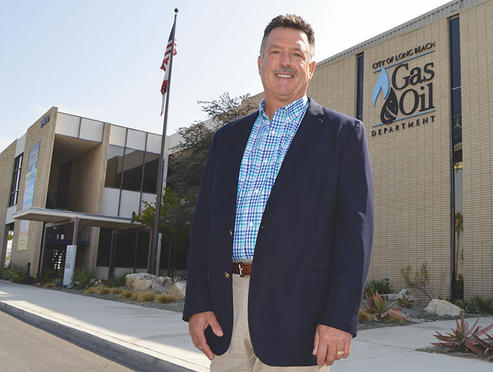Continuing low prices for crude oil, large reserves real and potential, and a tight regulatory environment in California make the outlook for the petroleum industry challenging in the short term, experts and industry members say.
“The commodity price environment remains the greatest challenge facing the industry both here in California and nationally,” William Blair, director of security and external relations for California Resources Corporation (CRC), Southern Operations, told the Business Journal.
The spot price for West Texas Intermediate (WTI) crude, used as a benchmark for monitoring oil prices, is expected to remain below an average of $43 per barrel in 2016. In 2017, it is expected to recover to only slightly more than an average of $51 per barrel, according to the U.S. Energy Information Administration. In comparison, WTI averaged more than $93 per barrel in 2014.

Robert Dowell is director of the Long Beach Gas & Oil Department, which services about 500,000 people and businesses in Long Beach and Signal Hill. (Photograph by the Business Journal’s Larry Duncan)
The low prices are good for consumers, but in a city and state where a significant part of the economy relies on the production, refining and sale of oil, low prices are a mixed blessing, Robert Dowell, director of the Long Beach Gas and Oil Department, says.
“Price recovery would spur some activity on the drilling side. Oil fields decline as they produce. And new drilling offsets some of that decline. If we could get some price recovery, that would be the thing we’re all keeping our fingers crossed for and are hoping to see,” Dowell told the Business Journal.
“On a tax base, there are more dollars assigned to the value of the crude in the ground, so there are higher taxes paid to the county. There’s more spending. There’s more activity. It’s really beneficial to everyone, not just the city on the sale of the oil, but there are several other entities that get hit on a reduction in commodity.”
Price recovery, however, is anticipated by experts to be a long process.
Production in the U.S. is declining, with crude oil production falling from 9.43 million barrels per day in 2015 to 8.19 million barrels per day in 2017. And demand has been higher than anticipated in the first half of 2016.
But inventory remains high, with U.S. crude oil stockpiles at 519.8 million barrels in June. (During the past five years, June stocks have ranged between 355.8 million barrels and 470 million barrels.) And oil is a global commodity. Wildfires in Canada temporarily halted substantial production earlier this year, while political instability in places like Nigeria and Libya have “shut-in” production there, according to the International Energy Agency’s (IEA) latest oil market report.
The potential for a downturn in increased demand, as well as the possibility of suddenly increased production joining the higher-than-normal stockpiles of crude, means that experts are predicting slow growth in prices, and they aren’t even confident about that.
“There are large volumes of shut-in production, mainly in Nigeria and Libya, that could return to the market, and the strong start for oil demand growth seen this year might not be maintained,” the IEA report stated. “In any event, following three consecutive years of stock build at an average rate close to one million barrels per day, there is an enormous inventory overhang to clear. This is likely to dampen prospects of a significant increase in oil prices.”
CRC says the outlook for its company is brighter than the outlook for the industry as a whole.
“CRC has a high level of operational control, meaning that we effectively operate all of our assets, which allowed us to quickly reduce capital investments this year when prices declined and favorably positions us to grow in a strengthening commodity market,” Blair said. “CRC is committed to living within our means, and we fund our capital budget internally with operating cash flow.
“By focusing on our core operations, we have sustained significant oil and natural gas production at lower operating costs without the need to drill new wells this year,” Blair continued. “We have also devoted our capital investments this year to our core facilities so that we are prepared for increased activity when commodity prices rebound.”
But not all are as confident. Catherine Reheis-Boyd, president of the Western States Petroleum Association, says the regulatory environment has created challenges for new production in California – despite reasonable, if pragmatic, policies from Gov. Jerry Brown.
“The governor has been rational about the need for California to produce crude oil. His approach has been practical – we’d be better off producing it here rather than shipping it in by rail or by tanker,” Reheis-Boyd says. “But there have been so many regulations placed on new production that it has been, in effect, a moratorium.”
Add it to discussion and debate about the future of the state’s climate change control policies, regulations on hydraulic fracturing and other elements of well stimulation techniques, and she calls the outlook challenging at best.
“It’s not a pretty picture for refiners in this state. It is not, in my opinion or the industry’s opinion, trying to strike a reasonable path forward. The math just doesn’t add up,” she says. “There needs to be some realism brought into the conversation.”
